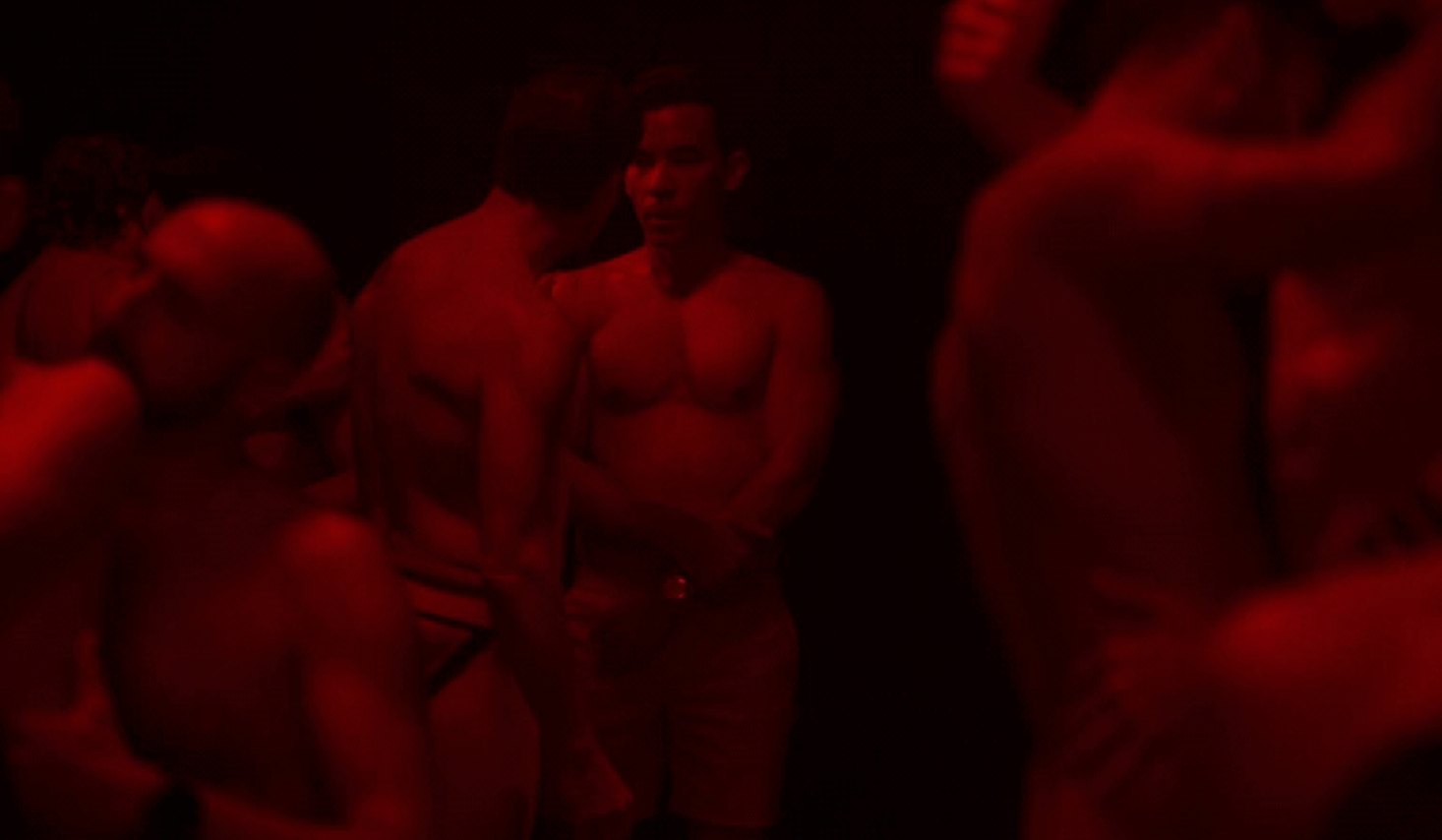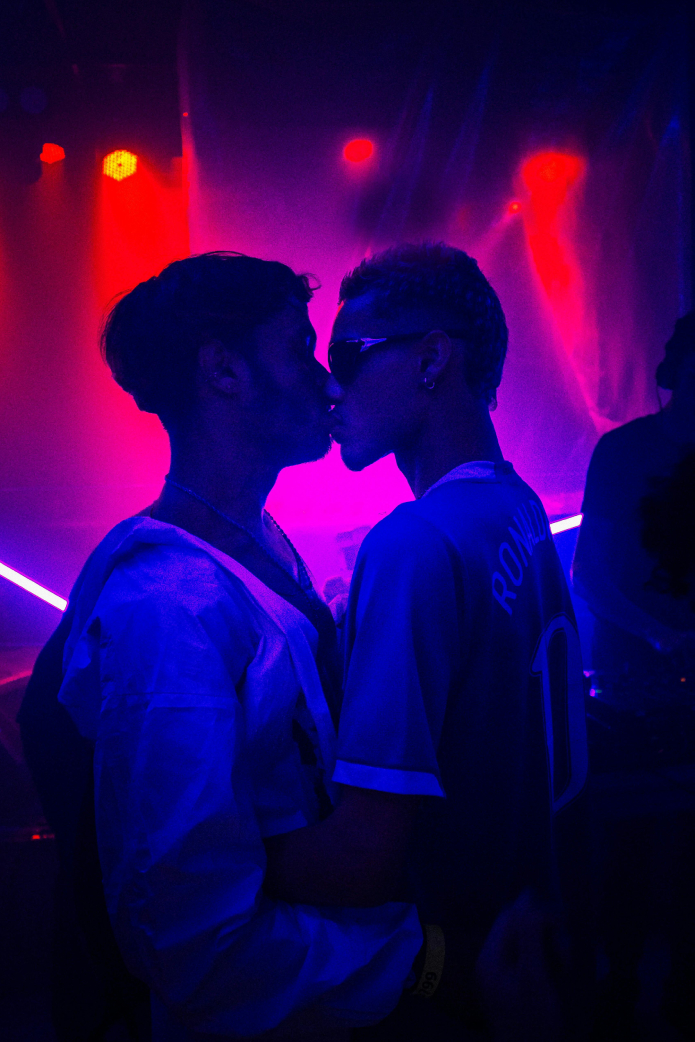
Okay, curious minds, it’s time to demystify the backroom, otherwise known as a blackroom, darkroom or playroom. Maybe you’ve spotted one on a night out and felt compelled to explore, but couldn’t quite bring yourself to do it. Perhaps you’ve been fantasising about anonymous group sex, but are feeling a little shy about making the next step. Or, maybe you’re raring to go and need a couple of pointers.
Whatever the case, we’ve got your back.
These sexy sensory rooms can be an intense exploration of intimate touching, skin-on-skin contact and unrivalled pleasure. Still, they can also be overwhelming if you’re not clued in on what to expect, how to read (often) non-verbal consent cues or how to express disinterest in someone’s advances.
Here, we bring together advice and experiences from the community along with guidance from experts to help you have the best possible time if you decide to explore these spaces for yourself. But before we hit you with a dos and don’ts list, let’s first give you the lowdown on what to expect so that you can enter these spaces fully aware of the body language and etiquette that make spaces like these so much fun.
What is the backroom?
The backroom is a dimly lit space found in gay clubs (though not exclusively) where people engage in group sex and anonymous sex. No two are the same, and each one will have its own unique layout and vibe, depending on the scene that’s taking place.
You might find glory holes, suckatoriums and tucked away spots for more close-up encounters.
The purpose of these rooms is to create a space for pleasure and anonymity. Despite this, it isn’t a free-for-all where anything goes. Yhere are rules, discretion and a non-verbal code of conduct to adhere to. This can add to the thrill of cruising, but it can also add a layer of complexity for newbies.
Molly Houses, backrooms and the obscured history of homosexual desire and intimacy
Backrooms, like saunas, have existed for hundreds of years. In the UK, backrooms were historically known as ‘Molly Houses’, a brick and mortar meeting spot for men looking to have sex with other men, and can be traced back as early as the 17th century. However, it’s almost impossible to pin down where, exactly, they began.
“You have to remember, these spaces were deliberately obscured; they were never meant to be discovered–unless you were in the know.” Says Dr Anthony Delaney, author of Queer Georgians: A Hidden History of Lovers, Lawbreakers and Homemakers, and presenter of dark history podcast After Dark on the History Hit network, tells Gay Times.
“Essentially what I have concluded after years of thralling through the pre-modern queer archive is that as long as what we would term queer people have existed so too has this type of meeting spot in one form or another,” he says.
Dr Delaney explains that, not unlike today, these were the main spaces where men who wished to meet other men came together to build community, foster intimacy, play with gender norms and have sex. However, unlike today (in the West at least), men who frequented these spaces put themselves in extraordinary danger.
“Access was often granted by a patron who was already familiar with the house,” explains Dr Delaney, “because you have to remember, attendance at one of these spaces in the 18th century was quite literally a life and death exchange.”
This was thanks to The Buggery Act of 1533, one of Henry VIII’s long lasting pieces of harmful and discriminatory legislation (it wasn’t repealed until hundreds of years later in 1828, and even then… things only improved marginally). Dr Delaney points out that, because of this legislation, if it could be proven that penetration between an ‘agent’ (a top) or a ‘pathick’ (a bottom) had occurred, then the ‘guilty’ parties could be hanged.
“The molly house itself was not the same thing as what we would understand as a backroom today,” Dr Delaney clarifies, explaining that while some things have stayed the same, other aspects are fundamentally different.
“The molly house was more akin to a proto-gay bar. But within these taverns there were rooms into which men would go together and, as one journalist observed in 1709, ‘enter upon their Beastly Obscenities, and to take those infamous Liberties with one another, that no Man, who is not sunk into a state of Devlisim, can think on without Blushing…'” He recites, “I’ll leave the finer details of what those ‘Beastly Obscenities’ might have entailed to your imagination….”
How do I know if I’m ready for backrooms?
Group sex, particularly anonymous group sex, is thrilling, risky and a little dangerous. That is partly why so many people love to do it.
Genevieve Collister Brown, Psychosexual Relationship Therapist, explains that there is so much to enjoy and be excited about. That being said, there are some questions you can ask yourself before jumping in headfirst to make sure you’re ready for the all-consuming experience of the backroom.
Questions to ask yourself:
Brown, who specialises in gender, sex and relationship diversity, suggests the following:
- Mentally, are you feeling secure and grounded? These interactions can be overwhelming, you could get rejected lots and feel low or lonely.
- Are you comfortable with it going many different ways? They’re unpredictable, it could be surprising, super hot or anticlimactic.
- Have you thought about your wants and limits? Do you feel able to stick to these?
- Do you understand the risks of STIs? Are you prepared and have what you need?
- Do you understand the emotional highs and lows that can come with play like this? What might you need after, and how can you give this to yourself?
“If hooking up with strangers is appealing, if you feel able to communicate in this kind of way and this kind of space, if you’re excited by the prospect and open to the wide range of possibilities, then maybe you want to try it out,” says Brown.
“Take it at your own pace, you don’t have to be fearless, just be in touch with yourself and enjoy exploring!”

Photo by Ivson Laurenco
What to expect when you enter the backroom for the first time: The dos and the don’ts
“It’s dark in a darkroom!” says Brown, “I know that sounds obvious, but it’s worth mentioning, you might feel disoriented when entering, so find a spot where there’s a bit of light to get your bearings.”
Brown explains that darkrooms can feel overwhelming to navigate, especially if you haven’t got the etiquette down. They explain that the whole point of these spaces is that they’re private, “so don’t take photos or use your phone,” they advise, before continuing, “Don’t out anyone or talk about people you’ve seen or interacted with once you’ve left.”
How you move in these spaces has an impact on everyone’s experience. “It’s fine to stand on the edge and watch for a little bit,” Brown says, “but be mindful that staring without giving any cues that you want to engage can be unnerving.”
Body language is one of the most important elements of backroom etiquette. So knowing how to read it, speak it and respect it goes a long way in making sure you and the others you’re with enjoy their experience.
In short, knowing how to read and express non-verbal consent cues is crucial.
How to revoke consent and say no without speaking.
“Even though darkrooms are mostly non-verbal spaces, consent can still be revoked at any time,” Brown states.
So, whether you’re in the thick of things, switching up positions or suddenly feeling like you’d like to stop. It’s your right to express how far you’d like to go, when you’d like to go there, and perhaps most importantly, to change your mind even if what you’re doing is exactly what you’d originally consented to.
If you want to express your disinterest, Brown suggests shaking your head, physically pushing advances away in a non-confrontational manner, or moving to another location. And, if you still feel unheard, don’t be frightened of saying “no” out loud if you’re not interested.
Equally, if someone moves away from you without explanation, take it as a “no” too.
How to check in and make sure you’re still having a good time
It’s easy to get swept up in the thick of it, but it’s important to keep tabs on how you’re feeling.
“People can join or leave, and with that, the energy can quickly shift and play can become more intense or rough,” Brown explains. “Sensory wise, they’re dark, music can be loud, it’s so easy to start off feeling excited and then suddenly feel disconnected or overwhelmed.”
If this starts to happen, they suggest checking your body for signs you’re still engaged.
“Are you breathing steadily or holding your breath? Are you feeling present or spacey? Is your body warm and open, or tense or numb? Has your arousal dropped suddenly?” Brown asks.
If you ask these questions and realise that, actually, you’re done or have had enough, then don’t worry.
“The group will keep going, you’re not responsible for the vibe. It’s easy to get swept up in the pace and intensity, so permit yourself to slow down, take breaks and stop at any time,” advises Brown.
Community experiences
The Sexpert from New York City says that exploring the scene helped him to connect to aspects of himself.
“I felt like something finally clicked,” he tells Gay Times, “I felt connected to the generations of fags who came before me, and finally understood their stories and their messages and their traumas and their pleasures in a deeper way than I ever realised was possible. “
“In some ways, queerness is about being in the ‘backroom of society’, he reflects, explaining that it’s “about finding ourselves in the margins, and embracing all the fraught and wonderful things that come with that.”
Parting advice
Remember, not all backrooms are male-only spaces. Depending on where you find yourself, you may find people of all genders and orientations.
Additionally, Brown stipulates just how important it is to be gentle with yourself and to have aftercare in place.
“Talk to people you trust about your thoughts or experiences (whilst maintaining anonymity) and trust your instincts about what feels good and right for you,” they say. Otherwise, have fun!
